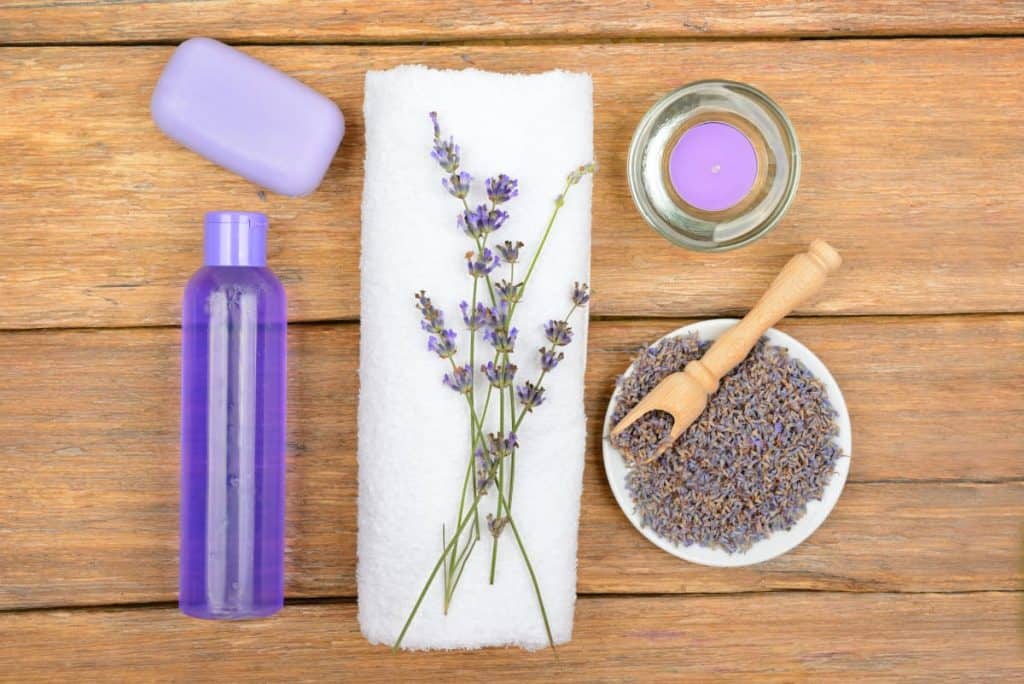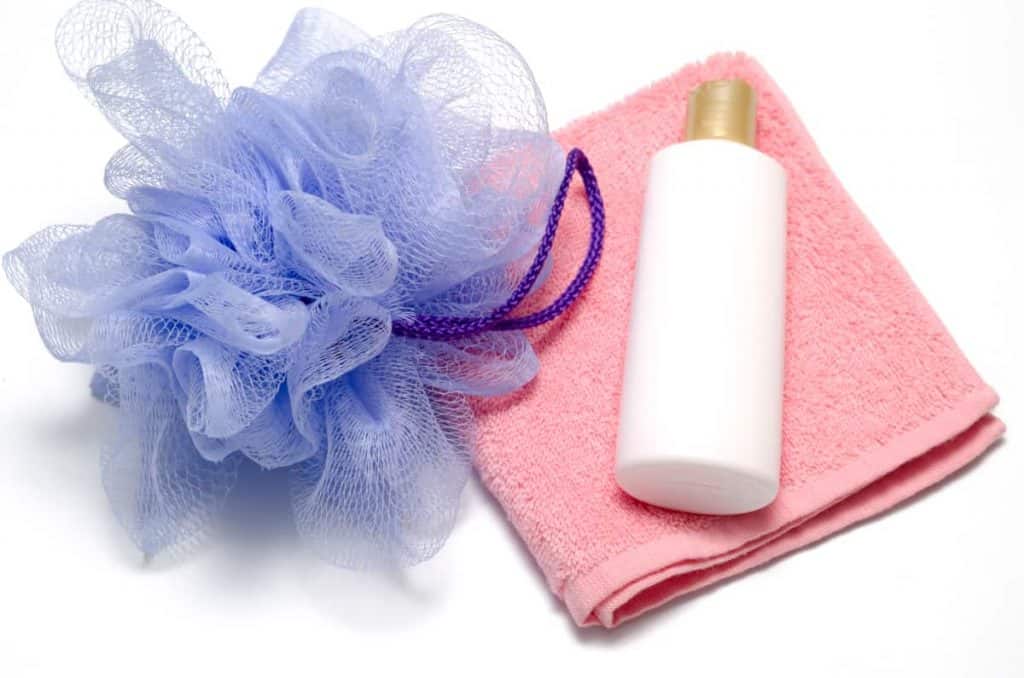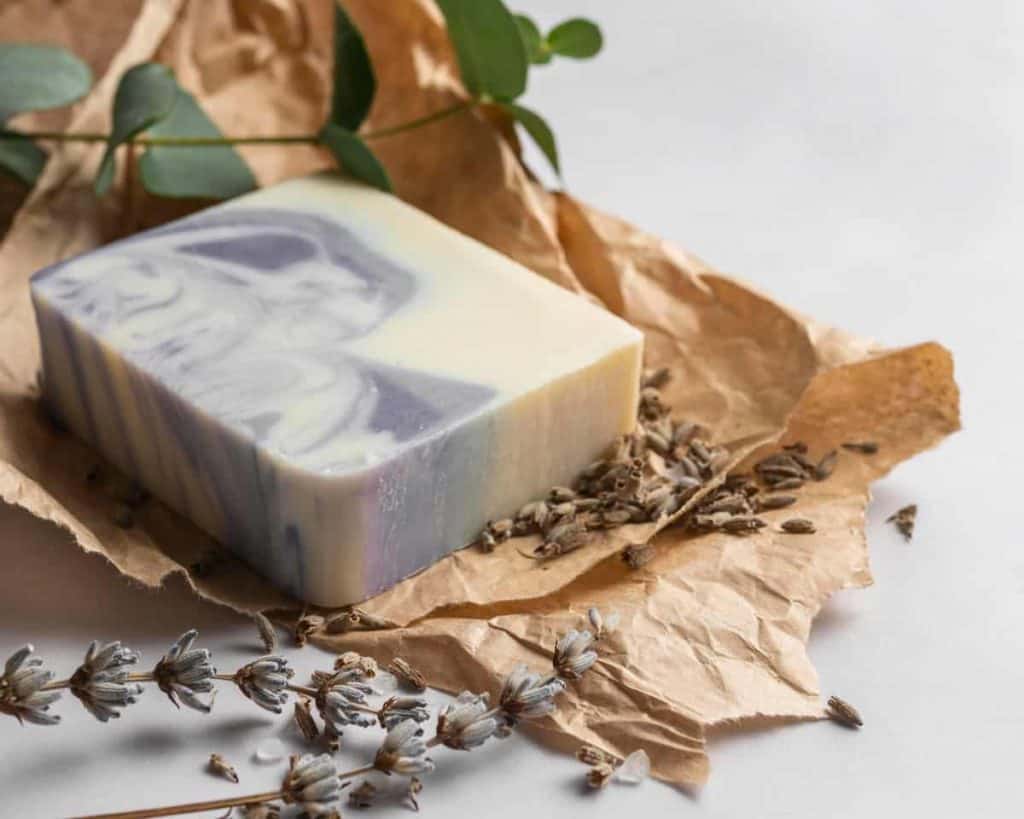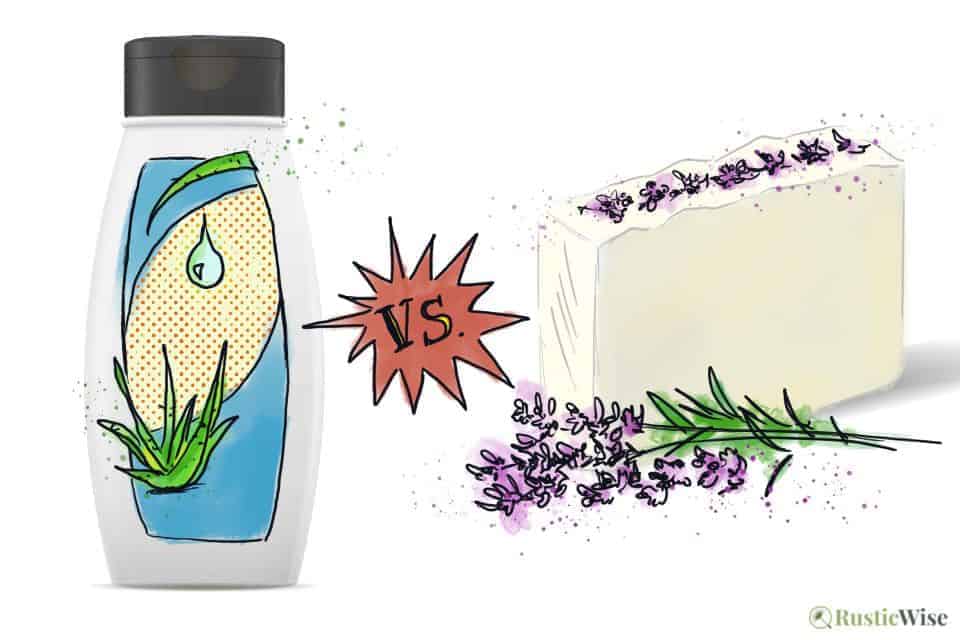Body Wash vs. Bar Soap: Here’s the Lowdown on Getting Clean
The skin is the body’s largest organ, so maybe it’s no surprise that we all can’t agree on how to best clean it. Whether your daily skin care routine consists of a motley collection of cleansers, creams, and serums, or simply a bar of soap, we’ll look at the pros and cons of body wash vs. bar soap.
If you’ve ever received skincare advice like, “don’t wash your face with soap,” you should know that today’s soap bars aren’t the drying bars of yesteryear.
Most bars of soap today (whether handmade or store bought) contain some moisturizing element. And the massive selection of body wash available can make your head spin.
Whether you’re on Team Soap Bar, or Team Body Wash, (or plain undecided), keep reading for more tips on selecting the right cleanser for your skin, plus what’s really in those soap bars and body washes.
Are there any significant differences between a soap bar and body wash?
The most obvious difference between a bar of soap and body wash is that the former is a solid, while the latter comes in liquid form. There are also some slight variations in the ingredients used (which we’ll cover below).
Aside from that, both are effective at cleansing the skin. Both are surfactants, which means they contain special molecules which reduce surface tension and bind to both water and oil to clean and remove oil and impurities from skin.
Whether your skin is left feeling dry or moisturized really depends on the ingredients in your specific product.
In other words, if you encountered a nasty soap bar, or an awful body wash that just left your skin feeling parched, it might just be that specific product.
The takeaway: Soap and body wash both clean the skin. The degree to which they leave your skin feeling moisturized really depends on the specific product’s ingredients. After that, it boils down to personal preference and whether you prefer to suds up with a bar or a liquid wash.

What the science says about soap and cleaning power
If you’re wondering whether soap vs. body wash is better at cleaning, it’s a tie.
Cleanliness has more to do with the method of washing (and how thorough you are) than the type of soap you’re using.
By now, we all know proper handwashing technique. The Centers for Disease Control and Prevention (CDC) says to effectively wash your hands, it requires careful scrubbing of hands (and all nooks and crannies under nails) for at least 20 seconds.
What type of soap (or body wash) you use doesn’t really matter.
What about pH levels?
Our skin is naturally acidic (hence the term acid mantle). Healthy skin has a pH range of 5.4–5.9.¹
(If you recall, the pH scale ranges from 0 to 14 with 7 being neutral. Anything below pH 7 is acidic, while those above 7 are alkaline or basic.)
This acidic quality of skin allows “good” bacteria to flourish to protect the body from harmful bacteria and environmental pollutants.
If you’re using skincare products (particularly those that you leave on, like creams) that are more alkaline, this may alter the skin’s natural pH levels. You may experience dryness or skin irritation.
So what’s the pH of most soap and body wash? Most soaps (commercial or handmade) and body washes are alkaline with pH 8 or 9 and above.
Luckily, this isn’t anything to worry too much about. With soap and body wash, it’s something you apply to skin and rinse off quickly.
A 2015 study shows that any disruption to the acid mantle is temporary. Researchers studied the effects of using a soap-based (alkaline) cleanser vs. a mildly acidic cleanser on the forearms of participants over 5 years.²
Researchers evaluated the pH on the inner forearm of subjects before and after six hours of using a soap bar. They did not notice any difference between the pH levels on skin between the two groups before cleaning, after cleansing, or in the six hours following the cleansing.
Skip the antibacterial stuff
And no, we really don’t need antibacterial soap, or body wash, for that matter.
The U.S. Food & Drug Administration (FDA) says plain soap and water for washing works just fine. You don’t need antibacterial products for everyday use.³
Using normal soap combined with proper handwashing technique can reduce bacteria on hands by 82 percent.⁴
In fact, the FDA has banned the use of triclosan and triclocarban (two ingredients used in antibacterial soaps and other skincare products) as of 2016.
Triclosan is linked to many health problems in different areas, including heightened asthma, hormone disruption, and poor gut bacteria.
In healthcare settings, they still use triclosan in some products.
A closer look at the ingredients in body wash vs. bar soap
Not all soap bars and body washes are created equal.
It’s important to read the label, or know what’s exactly in the stuff you’re rubbing on your skin.
While every product contains unique ingredients, let’s look at what you’ll commonly find in the following types of skin cleansers.
Homemade soap bar ingredients:
- Water.
- Vegetable oils (such as olive oil, coconut oil, or palm oil).
- Animal fats (such as lard or tallow). Some soap bars are vegan and contain no animal products.
- Sodium hydroxide lye. This is an essential ingredient required to convert oils/fats into soap molecules; don’t worry, there’s no active lye in the finished product.
- Glycerin (which is a natural byproduct of the homemade soap making process).
- Any essential oils or fragrance oils, and additives or colorants.
Commercial soap bar:
- Water.
- Synthetic detergents (often petroleum-based) to clean the skin.
- Sulphates, particularly sodium lauryl sulphate (SLS) and sodium laureth sulphate (SLES). Sulphates are chemical surfactants which create foam and lather. They help to remove oil and grease. These may leave skin feeling dry.
- Added glycerin.
- May contain parabens and other chemical chelating agents to prevent soap scum.
- Synthetic fragrances.
- Synthetic dyes.
Commercial body wash:
- Water.
- Synthetic detergents (often petroleum-based) to clean the skin.
- Sulphates, particularly sodium lauryl sulphate (SLS) and sodium laureth sulphate (SLES). Sulphates are chemical surfactants which create foam and lather. They help to remove oil and grease. These may leave skin feeling dry.
- Emulsifiers which create foam and thicken the consistency of the liquid.
- May contain parabens and other chemical chelating agents to prevent soap scum.
- Preservatives to ensure the liquid doesn’t grow bacterial and enables a long shelf life.
- Synthetic fragrances.
- Synthetic dyes.
- Moisturizers. Many body washes include skin nourishing oils such as jojoba oil, sweet almond oil, etc.

Pros and cons of body wash
So let’s take a deep dive into the pros and cons of soap vs body wash.
Pros of body wash
Contains moisturizers
Many body washes contain skin emollients that moisturize the skin after cleansing.
These moisturizers may help restore the skin’s natural smoothness and suppleness.
Moisturizing body washes are great for people with dry skin and those who want to moisturize and cleanse the skin in one convenient step. Some people experience less discomfort associated with dry skin after using body wash.
Possibly more hygienic?
If you’re the sort of person who really doesn’t like the idea of sharing a bar of soap in the shower, then a bottle of body wash may be more your style. Simply squeeze body wash onto a loofah or washcloth and scrub!
But stop right there. A loofah or washcloth can also be a breeding ground for bacteria, mildew, and dead skin cells if not properly washed between uses and hung to dry.
So while it’s true that you don’t need to worry about someone else’s germs touching your liquid body wash, don’t neglect the cleanliness of your loofah or washcloth either!
Cons of body wash
More chemical ingredients
Compared to a bar of natural soap, most commercial body washes contain a plethora of chemical ingredients (many of which I can’t pretend I know how to pronounce).
From synthetic surfactants to emulsifiers, and preservatives to artificial fragrances, the contents of body wash are not basic.
While not all chemicals are “bad,” if you’re looking for a simple and natural product to cleanse and moisturize your epidermis, sadly most body washes don’t fit the bill.
Harder on the environment
For one thing, all that liquid body wash must be stored in a plastic squeeze bottle. While many are recyclable, the reality is that a large portion of plastics destined for the recycling facility end up in the landfill.
Liquid soaps and body washes also burn up more energy.
Researchers from the Swiss Federal Institute of Technology in Zurich found that soap bars require just one-fifth of the energy compared with the production of liquid soap.⁵

Credit: Vector State
Pros and cons of bar soap
Pros of bar soap
Homemade bar soap often contains quality ingredients
Homemade natural soap bars made from scratch often contain simple ingredients such as various skin-nourishing vegetable oils (coconut oil, olive oil, safflower oil), butters (think cocoa butter or shea butter), water and sodium hydroxide lye (don’t worry, this harsh ingredient is used to convert oils/fats into soap molecules, no active lye remains in the finished product).
There are so many natural soap bar options available to suit various skin types.
Did you know that most “soap” products you’ll find on store shelves are not actually soap, but detergent? Most commercial soap bars don’t meet the definition of real soap (a derivative of alkali salts from fatty acids). Instead, most commercial soaps are “syndet bars” which is a synthetic detergent bar. Many syndets use SLS or SLES which may strip the skin of natural oils.
Gentler on the environment
Most of us can agree that the less packaging we use, the better, right?
Most soaps, whether store bought or handcrafted, use minimal packaging with little to no plastic. Many come in cardboard that’s recyclable.
More budget-friendly
Unlike liquid body wash, which consists mostly of water, a bar of soap generally lasts longer. Most bars of soap cost just a fraction of the cost of a standard body wash bottle.
You’ll likely get more washes out of a standard soap bar than a bottle of liquid body wash.
Cons of bar soap
The bacteria factor
While nobody would want to use a bar of soap left in the shower at the gym, it’s quite another to use it within the same household (or maybe that’s just me).
It’s a common fear that soap bars harbor harmful bacteria. While it’s true that the surface of bars carries some bacteria, the same could be said about the soap dispenser.
An often-cited 1998 study looked at whether soap bars actually transmit bacteria.⁶
Researchers inoculated soap bars with bacteria (Escherichia coli and Pseudomonas aeruginosa). They asked 16 participants to wash their hands as normal with the inoculated bars. None of the participants had detectable levels of the test bacterium on their hands.
(This study was commissioned by a soap manufacturer, so you may take the results with a grain of salt.)
Still, the CDC doesn’t specifically indicate whether bar soap or liquid soap is preferable.
The takeaway: Some people simply refuse to use a soap bar no matter what. But for those who are undecided, rest assured the risk of you getting sick from using the same soap bar as your roommate is very low.
Requires proper storage
Unlike a plastic bottle of liquid wash that can be kept directly in the shower stream, a soap bar requires a bit of care.
Keep it out of sitting water to avoid bacteria from breeding. It’s best to use a soap dish with drainage to prevent it from sitting in a puddle of water and melting away. Try to keep it dry between uses to extend shelf life.
Perceived to be more drying
This really comes down to the type of soap bar you’re using and the ingredients it contains. However, some people perceive bar soap to be more drying on skin.
And perception plays a large role in whether someone actually ends up using a bar of soap or not.
Many people would consider liquid body wash to be more moisturizing (although that’s up for debate).
Ingredients to stay away from
Whether you’re firmly in the bar soap camp, or a fervent supporter of body wash, there are some ingredients everyone should stay away from.
According to the U.S. Environmental Working Group (EWG), here are a few ingredients to avoid in your soap products:⁷
- Triclosan and triclocarban: We mentioned above that the FDA banned the use of these two ingredients found in antibacterial products in 2016, but that applies to household products. Some soaps and cleaners in hospital or industrial settings may still contain triclosan and triclocarban. These are linked to endocrine disruption and are harmful to the waterways.
- Synthetic fragrances: Most commercial soaps and body washes contain artificial fragrance. Each individual fragrance may consist of dozens of chemicals. But you wouldn’t know it as federal laws don’t require producers to list individual fragrance components. Those with sensitive skin or dry skin should avoid products with synthetic fragrances.
- Parabens: The term parabens involves a broad group of chemicals, but typically includes those that begin with propyl-, butyl-, isopropyl-, and isobutyl-. Parabens are also linked to developmental, endocrine, and reproductive issues.
- Phthalates: You’ll find this chemical group often in artificial fragrances. They have been linked to issues with male reproductive systems.
Find a product that suits your skin type
Still trying to figure out whether to use body wash vs. bar soap? Well, the answer is to find a product that meets your unique skin care concerns.
For dry or sensitive skin:
- Avoid using skincare products with synthetic fragrances, or dyes which may irritate skin.
- Stick with mild cleansers.
- Look for skin nourishing ingredients such as argan oil, cocoa butter, coconut oil, jojoba oil, olive oil, shea butter, and safflower/sunflower oil.
For flaky or rough skin:
- Look for natural exfoliants to slough off dead skin cells. Many natural soap bars contain exfoliants such as finely ground oats, coffee grounds, sea salt, or sugar.
For oily skin:
- More alkaline products such as soap bars may be helpful to remove excess oils.
The verdict: body wash vs. bar soap
There’s no clear winner here—it all boils down to personal preference. But if I had to pick a side, I would definitely choose natural bar soap. Once you’ve tried a bar of handcrafted soap that suits your skin type, you probably won’t go back to commercial soap bars.
I also prefer soap bars for their eco-friendly (and wallet-friendly) qualities.
But that’s just my two cents!
Related questions
What is the difference between body wash and shower gel?
While these two terms are used interchangeably, the difference lies mainly in their texture. Body wash is typically more aqueous (think liquid soap), and often more moisturizing. Shower gel, as the name implies, has a slightly thicker and firmer texture.
What is whipped soap?
Whipped soap is a light, fluffy, and creamy skincare product that straddles the line between regular soap and body wash. This multi-purpose product with a mousse-like consistency can be used as soap, shower gel, or shaving cream.
New to making soap? 🧼❓
👉We have a fantastic overview on the whole soapmaking process here: read our Timeless Guide To Soapmaking.
If you would like to see our soapmaking posts organized by topic type, see our Soapmaking Collection.

References
- Tarun, Jose et al. “Evaluation of pH of Bathing Soaps and Shampoos for Skin and Hair Care.” Indian journal of dermatology vol. 59,5 (2014): 442-4. doi:10.4103/0019-5154.139861
- Takagi, Y et al. “The long-term use of soap does not affect the pH-maintenance mechanism of human skin.” Skin research and technology : official journal of International Society for Bioengineering and the Skin (ISBS) [and] International Society for Digital Imaging of Skin (ISDIS) [and] International Society for Skin Imaging (ISSI) vol. 21,2 (2015): 144-8. doi:10.1111/srt.12170
- U.S. Food & Drug Administration (FDA), “Antibacterial Soap? You Can Skip It, Use Plain Soap and Water,” https://www.fda.gov/consumers/consumer-updates/antibacterial-soap-you-can-skip-it-use-plain-soap-and-water. Accessed March 2022.
- Rangel, Gabriel (09 January 2017), “Say Goodbye to Antibacterial Soaps: Why the FDA is banning a household item,” Harvard University. Accessed March 2022.
- Lott, Melissa C. (28 January 2016). “The Benefits of a Bar (of Soap, That Is), Scientific American, https://blogs.scientificamerican.com/plugged-in/the-benefits-of-a-bar-of-soap-that-is/. Accessed March 2022.
- Heinze, J. E., & Yackovich, F. (1988). Washing with contaminated bar soap is unlikely to transfer bacteria. Epidemiology and infection, 101(1), 135–142. https://doi.org/10.1017/s0950268800029290
- U.S. Environmental Working Group (EWG), Top Tips For Safer Products, https://www.ewg.org/skindeep/contents/top-tips/. Accessed March 2022.

Author: Josh Tesolin
Josh is co-founder of RusticWise. When he’s not tinkering in the garden, or fixing something around the house, you can find him working on a vast array of random side projects.









